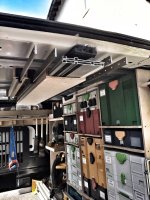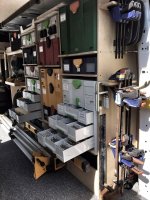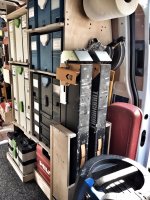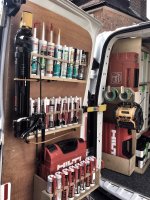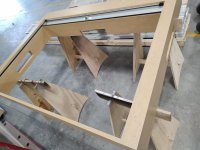Crazyraceguy
Member
- Joined
- Oct 16, 2015
- Messages
- 5,548
Wow Ron [eek] that's a lot of equipment in a small space. The biggest problem I have with space is not really the amount, it's not ideal, but I am just one guy. I'm switching from huge commercial projects, to much smaller personal furniture, cabinetry, and boxes. I really want to embrace my Shaper Origin too.rvieceli said:[member=58857]Crazyraceguy[/member] to give you some hope [big grin] my shop is a 20x20 garage. That’s the outside dimensions. Inside I’ve got a 16 inch Oliver jointer (1945) that’s 106 inches long, a 20 inch planer, a 20 inch bandsaw (1974), a 1969 Powermatic 66 with only 30 inches to right of the blade plus a 16 inch Electro-Mechano drill press (1963) About 24 inch deep storage along 2.5 of the walls. Also a bigger but not gigantic cyclone shoe horned between the jointer and the garage door.
The advantage of the small shop is you don’t have to take hike between machines [tongue]
The disadvantage is that there’s not a lot of space to work on multiple projects at the same time.
I’d like about 1500-2000 square feet so I could have a dedicated welding shop but space that could be turned into a shop is not very available in our town. The city bulldozed a bunch of old railroad warehouses several years back for a highway overpass that never materialized.
I’m not sure I can get the ROI I’d need to build something.
Ron
My space problem is actually shape. I have a 2-car garage, but it is far from typical. If it housed 2 cars, they would be in line with each other, rather than side-by-side. It has a total length of around 40 feet, but it's only 12' wide. That would also eliminate all of my storage options of the garage space itself.
It this point, I am partitioning it into 2 sections, limiting the shop space to 12' x 24', leaving some unheated garage behind it. There is a bit more space to be utilized between the shop and the man house, however it is an odd L shape, also only 12' wide each way. This area could be used as somewhat of a hand tools area, with a specific spot for the Origin. It currently houses my metal working tools and wood lathe, though some reorganizing may have to happen. This way I can keep the mentality of my big MFT style assembly table, and have a more traditional woodworking bench in the other room. I also have some basement space, but breaking up into all of these areas is definitely not appealing.
The MFT is still going to have to shrink from its current size though.
At this point, my plan is to put my mitersaw station (as it currently is) along one of the long walls. Then put the Festool Sysports on the opposite side. This will leave about 7 feet between them. My MFT is 4' wide, so that's a no-go. Even if I cut it down to 3', that still only gives me 2 feet on each side. I currently have 3' between the bench and the Sysport cabinets.
This is part of the mental gymnastics that I am going through. I may have to reconfigure the whole thing and incorporate the mitersaw into the Sysports? That is how I had it initially, during the rebuilding of my equipment supply after the fire, but that was when I had far fewer Systainers to store.
I have modified the mitersaw station to hold other things, drawers, etc in the mean time.
I am used to having 12' of open countertop above the Sysports now though, plus the CT on the end. That 14ish feet, plus the big black box on the end effectively uses up that 24', since there is a doorway on the side wall of one side. I can't move the mitersaw to an end wall, since they are too short.
This is still a work-in progress, I have yet to settle on a design, and I don't want to regret and redo it.
The whole thing is at least partly why I haven't just retired and left yet. While I am still there I have access to resources to get this done and my tools are not packed up and difficult to access. Plus, I have a trainee/apprentice to teach. I certainly can't wait long enough to see him through to where I am really confident in him, he is way to green and it takes years to come across all of the variants of things this job entails.
Sorry, this wasn't really supposed to be about me, it just kind of flowed into that, because this topic is top of mind.
Batch processing is definitely a great asset. Even with these big projects that I build, I try to get as much done at one time as possible. Sometimes it's just not practical as far as space, either for building, or for storing afterward. Just because I get it built, does not mean that the jobsite is ready to take it.Packard said:Build something (anything) twice in a row. It will teach you a lot.
Build four of something, but think of how to do it efficiently. That might mean cutting all the parts to size at one time.
It might mean making simple marking fixtures. (I do this often. It pretty much eliminates measuring errors, or it guarantees all the items will have the same error.
Make simple assembly fixtures, etc.
Once I started making multiples, I gained a mindset that improved my efficiency.
This was my point earlier about making and marking jigs, so things are repeatable.
Those angled desk units that I built for a local hospital are very repetitive, only differing slightly in a few dimensions. It would have been far more efficient to have built them all at once and I do have the physical space to do that, but...each one goes to a different floor. Those floors are being remodeled one at a time, in phases of about 6 months. It's not feasible to have one sit for 6 months after completion, and another for a year? Laminated parts (un assembled) in an unconditioned space, for that long is a recipe for disaster, and that's just from the weather factor. The potential for damage is there too.
I did another job, years ago, where there were many of the same/very similar desk units required. This was a new-build, which is why so many at once. There were 24 total. I built them over a period of a few months, mixing other things between. When the deadline push happened at the end, I built 4 of them at the same time, and this was in the old building(with far less space)
The point being both things work together, building multiples/batches, and keeping/marking jigs.
Even if you can't fully assemble the parts, if you have unique parts, that will be repeated later, cut them all at once. This is especially important in how they might fit on a sheet.
Radio, yes. I have pretty much always had one, in one form or another. Way back, before the internet made it far easier, I had a Sirius satellite radio connected to a boombox (of sorts) that I built for the space it fit into. Now a phone, Bluetooth jobsite radio and Spotify make it simple. Like [member=78000]twistsol1[/member] mentioned, I listen to stuff I have heard a million times, so there is no concentration involved. There are times when I walk back, to it playing away, and think "well that's doing nothing but wasting batteries" and laugh at myself. I could potentially be working 200 feet away from my bench.
This is the point of my router addiction. I have 2 of the full-sized Milwaukee set-up with flush-trim and pattern bits respectively. Several laminate trimmers with specific bits or specialty bases, and 2 router tables do the same. All of them are set up to do something that I need often. Some might go days or even weeks without action, but they are instantly ready. Excessive for hobby woodworkers, for sure, but it definitely helps in a pro situation.Packard said:At one point I was making a lot of drawers. Setting up the dovetail jig annoyed me for some reason. So I ended up with two identical Porter Cable jigs and two 690 routers. I left the setup as is all the time.
All I had to do to make drawers was cut the blanks and then walk over to the jigs.
I’m not building many drawers lately and “borrowed” one of the 690s for my router table. So, I have one jig/ router to setup. The other is ready to go.
Only the OF1400(and one of the MFK700) are free to do odd things.
SoonerFan said:One thing I attempted to do to improve my setup, skills, etc. was hire a more experienced woodworker like you to come to my shop and build cabinets with me. I wanted input on my tool setup, my process, digital design, etc. I found someone, selected the design software, and did the design. Then I was completely ghosted. Get returning my calls and texts. I have no idea why, Too bad because I was looking forward to learning a bunch from a pro. On a positive note my skills have improved a bunch since I retired and can dedicate more time. I am thankful for woodworking, cabinet making, etc as it gives me purpose and challenged in retirement.
Well, that's unfortunate. I wonder why he ghosted you? Maybe he felt like he under-priced what he was sharing and didn't have the guts to say it?
Anyway, "woodworking" (at least the way I see it) and "cabinetmaking" are quite different, but not mutually exclusive. One could be a legitimate woodworker, doing marquetry, jewelry boxes, turnings, trim carpentry, instrument making, etc. and never build a cabinet. On the other hand, one could build frameless cabinets, purely from sheetgoods, and never feel like that is "woodworking".
I have even been criticized, on other forums, for saying what I do with the big, laminated reception desks, is not really woodworking either. Of course, that's not all I do, but that is the mainstay of my job.
I am not much for the software side of it though. I have had some ancillary experience with it over the years, especially since the company changed brands of software about 10 years ago. There were some quirky differences that we had to work through. Software that excels in cabinet production has shortcomings in other things, curves and angles especially. In that case AutoCAD comes in, that's a completely different thing. For us, that is also 2 different people do it, and I get involved with both.
For me, retirement is an extension of all of this. I am getting into furniture making, for myself (so far anyway) My original goal is to remodel my kitchen, building it all in the garage of my house, the way it was done decades ago. Back in the day, kitchens, mantles and "built-in" shelves were built on-site. IE "built-in". With a house as old as mine, they were made from solid pine and painted. They are not individual units, installed in sections, as today. That would have been a waste of materials, in their eyes.
Sheetgoods where just not a thing yet, in the 1920s.
I'm looking forward to exploring my creativity with the Origin and possibly extending that into a stationary CNC machine too.
Wordy, sorry. It's Sunday morning and rainy. This has taken over an hour to type, while a sort-of watch TV at the same time.

